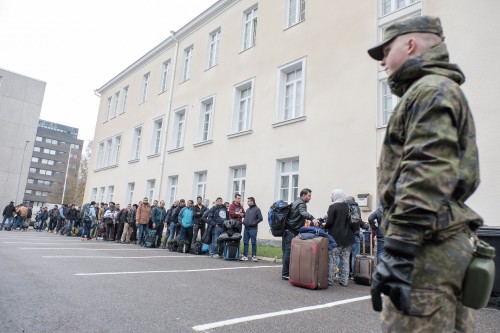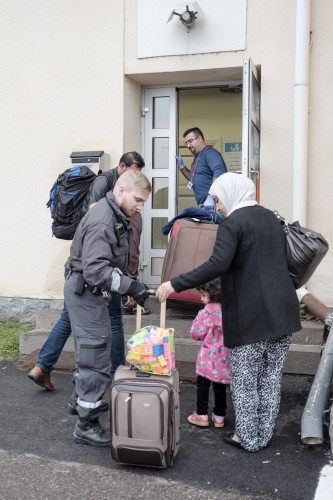
Fleeing from a vicious civil war, many Syrian refugees have encountered challenges along their way to a better quality of life. Many, as documented by photos, drowned on their way to the borders of the EU. They now face new obstacles, including prospects for jobs, whether or not their migration would make them refugees, as well as a continuing war that seems endless made worse by nations trying to make gains in the region.
While asking how the U.S. can help Syrian refugees, some outlets, like the New York Times and the Washington Post, have termed the humanitarian emergency the “migrant crisis.” The connotation is an important one to consider as countries address how they can help, as well as the solutions available given the situation.
Migrants and refugees are similar in the root of their meaning, implying movement, but that’s typically where the similarities end. The term “migrant” coincides with someone who moves for work or for better work prospects. Because of this, becoming a migrant is associated with the choice to leave one’s country.
Refugees, however, are people who are forced to flee their country, often out of fear of persecution and armed conflicts. For Syrians, as well as Iraqis, Eritreans and Palestinians who have fled their home countries and are now residing elsewhere, the choice was not entirely theirs to make.
Shailja Sharma, director of the refugee and migrant studies program at DePaul, said one possible reason behind this wording issue could be anti-migrant sentiments in European countries, as well as the use of terms “migrants” and “refugees” to color the public’s perception of the crisis
“People talk about the migrant crisis and about immigration, but it’s very important to know that it’s a refugee crisis,” Sharma said of the migrations that occurred after the Sept. 11 attacks. “Coming to these countries is really a last resort for them because they fear for their lives. Calling this a migrant crisis puts this flow of people into that context.”
[box]Read: Wars throughout world contribute to refugee crisis[/box]
The mass exodus of Syrian refugees to countries within the EU caught the attention of the media once there were many people flooding the borders of the countries, increasing the “trickle” of people, as it has been called, into European nations.
Four years of war has caused internal displacement as well, though the terms “refugee” and “migrant” are reserved for leaving a country. Though the terminology used in reference to refugees is important, solving the crisis that has uprooted their lives is also a concern.
“People don’t understand the full magnitude of the crisis. Europeans are talking about accepting 120,000 refugees but there are 4 million refugees from Syria.That number is only a drop in the bucket,” political science professor Scott Hibbard said. “The connection between the war in Syria and western Iraq are all part of a larger battlefield. Many people are missing the direct causal link. People don’t think about solving the war.”
The possible solutions for the crisis and the war are simple on paper. Non-affected countries should accept more refugees (the processes involved in accepting them should be expedited in this case), refugees should be able to obtain visas, and the war must end.
According to the Brookings Institute, 7.6 million Syrians are internally displaced while 4.2 million have sought refuge in neighboring countries, principally in Lebanon, Jordan, and Turkey. To accompany the 4.2 million, these countries have established refugee camps, but their quality is lackluster and they are draining national resources.

“European nations are not allowing refugees to seek asylum at their consulates in Turkey Jordan or Lebanon. Refugees need to be inside the European country when they want to apply for asylum,” Nezih Altay, a professor in the business school who has experience in humanitarian logistics, said.
One way to address this would be integration into society, Altay said. With the hope that the EU would provide better opportunities, many refugees have fled the camps, leading the global community and the news to finally see the refugee crisis.
Altay saw the desperation of the refugees first hand when he was vacationing in Turkey this summer. Because Turkey is so close to the Greek islands, specifically Lesbos, refugees — sometimes 15 or 20 at a time — would pile into small boats that would sink slowly into the water due to the excess weight, making it level with the surface of the water, Altay said.
This distance is closer than the distance between Libya and Italy. On this path many refugees have died due to the open waters and how easy it is for the boats to turn over in the rocky currents.
Once in the EU, refugees face other problems. Anti-refugee sentiment, as Sharma said, is high, especially in places like Hungary where there is fear that some of those entering the country are jihadists. Getting jobs and moving freely in the EU is another obstacle many face, due to their inability to obtain visas.
“A lot of people assume refugees are unskilled workers and some think they are taking advantage of their situation,” Altay said. “But many of these people are college educated. They had lives before the war that they can’t go back to now.”
The reason the U.S. is better at integrating refugees into its country than some others may be due to the number of refugees and crises it has dealt with. However, the initial number of refugees the U.S. gave refugee visas to since the start of the Syrian civil war was around 1,500. Though the number has been increased to 85,000 starting in October — 100,000 will be accepted in 2017, which is an increase from the current annual total of 70,000.
Ending the war would be the best option, though it is still unlikely. It would help assuage the refugee crisis, but the country would need years of rebuilding and governmental restructuring before it could really start to welcome back the people who fled from it.
ISIS would also need to be eradicated; its grip on Iraq and on Syria would have to be loosened, but currently — with Russia stepping up its support for Assad and the U.S. supporting one faction of the rebel forces — that doesn’t seem likely.
“The situation is kind of depressing. What you see going on is a lot of countries engaging in historic geopolitical competitions with one another and the Russians see Assad as key ally, but they’re absolutely heinous,” Hibbard said. “(There’s) a lot of blood on their hands, Russians and Assad. As of now, for an end to the war, I don’t see the light at the end of the tunnel.”

